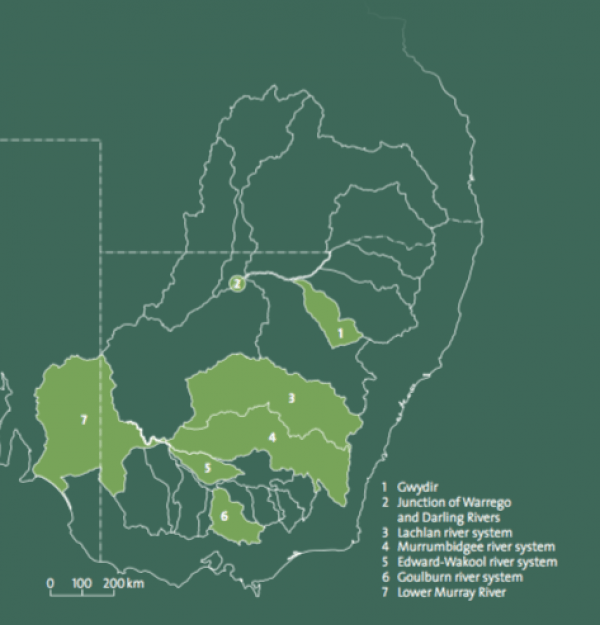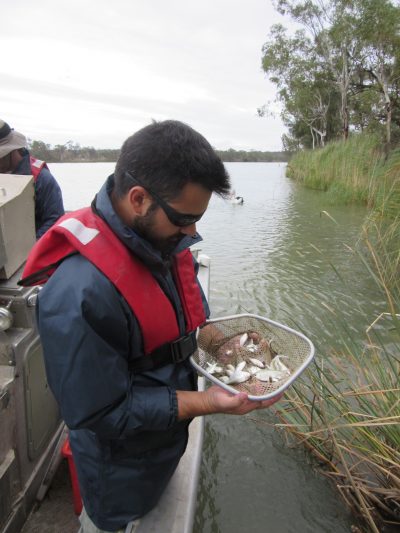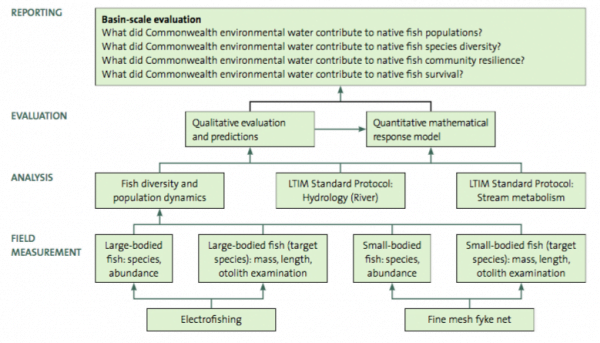In seven regions across the Murray-Darling Basin there is a lot of monitoring, measuring, analysing and testing going on. Why? To learn how environmental water impacts native plants, animals and ecosystems in different riverine environments. The focus of this work is to collect data across seven ‘selected areas’ (see map) in a consistent manner, to better understand the contribution of environmental water to protecting environmental assets, as well as enabling quantitative Basin-scale evaluations. These evaluations, undertaken over five years and at a cost of $30 million, will provide managers, planners and local communities with the ability to reflect, refine and adapt their environmental water management to gain the best on-ground results.

What does this mean in practice? It means that the long-term intervention monitoring can be used to improve outcomes from environmental water. Adaptive management of environmental flows is occurring in all ‘selected areas’ over short-time scales, with evaluation results being used in real-time communications to inform environmental watering decisions, as well as underpinning annual watering plans and on-ground management decisions.
Longer term, the project is providing a wealth of targeted empirical data to help us better understand ecological responses to flow restoration in Australia’s most flow-impacted river systems.

Scientist George Giatas (SARDI) counting Bony Herring in the Lower Murray in April 2016.
Adaptive management in practice: Goulburn River case study
Environmental water delivered to the Goulburn River during the 2014-15 water year is a good example of environmental water holders working in close cooperation with local water delivery partners, community groups and scientific monitoring teams, to design watering events that lead to good ecological outcomes, while meeting community needs.
Based on scientific results from previous years, environmental water deliveries to the Lower Goulburn River focused on increasing base flows throughout the year to increase food and shelter for native fish and water bugs. Additional ‘freshes’ (pulses of higher river flow) were then delivered in spring and autumn to provide cues for native fish breeding and passage, maintain water quality and support plant growth on riverbanks.

These deliveries for the environment were timed in consideration of community needs and feedback from meetings between the Commonwealth Environmental Water Holder and community representatives, including local members of parliament. What came out of these meetings was a two-week window of low flows being provided in between November water ‘pulses’ to give irrigators access to pumps. All pulses were timed for completion by 1 December to avoid potential disruption to local angling activities.
Long-term intervention monitoring undertaken on behalf of the Commonwealth Environmental Water Office, and led by the University of Melbourne in partnership with local water managers and multiple research institutions, confirmed that the environmental water delivered during spring played an important role in triggering the largest ever recorded Golden Perch spawning event for a managed flow in the Goulburn River.
Monitoring also found after the spring freshes, increases in the number and types of water bugs and the re-establishment of flood-tolerant plants on the riverbank. This increase in bugs and plants are important for providing food and habitat for native fish, as well as for stabilising riverbanks.
Long-term intervention monitoring and evaluation is ongoing in the Goulburn River, with water holders and local water managers working closely with scientific and community partners to ensure that the health of this important system continues to improve, and that native fish not only spawn, but grow to adulthood.
The three figures below demonstrate how environmental water has been used in the Goulburn River and the many different factors contributing to management decisions.
Light green is environmental water | Dark green is inter-valley transfers | Light blue is other passing flows
Mid-Murrumbidgee wetlands: Yarradda Lagoon
Yaradda Lagoon in the mid-Murrumbidgee wetlands is another positive example of how monitoring and evaluation can shape the way environmental water is delivered to achieve improved ecological outcomes.
Historically, Yarradda Lagoon was frequently connected to the main river channel and very rarely dried. Like many wetlands in the mid-Murrumbidgee, however, the reduced frequency of minor and moderate river flows caused the wetland to dry out for several years between 2001 and 2010.
Recovery of plant and animal communities at Yarradda Lagoon was guided by a combination of longer-term data collected from the wetland between 1998 and 2014, and the more intensive monitoring and evaluation activities undertaken as part of the Commonwealth Environmental Water Office’s Long Term Intervention Monitoring project.
 In 2014, monitoring of Commonwealth environmental water led by Charles Sturt University, identified very small patches of Spiny Mudgrass, Tall Spike Rush and Fringe Lily. These are relatively long-lived wetland plant species and require annual inundation, as they can only tolerate short (preferably less than one year) drying periods. Follow up environmental watering was scheduled to allow the cover and extent of these species to increase. As vegetation communities started to recover, wetland dependent animals also arrived, with the vulnerable Southern Bell Frog successfully breeding at Yarrradda Lagoon in 2015-16.
In 2014, monitoring of Commonwealth environmental water led by Charles Sturt University, identified very small patches of Spiny Mudgrass, Tall Spike Rush and Fringe Lily. These are relatively long-lived wetland plant species and require annual inundation, as they can only tolerate short (preferably less than one year) drying periods. Follow up environmental watering was scheduled to allow the cover and extent of these species to increase. As vegetation communities started to recover, wetland dependent animals also arrived, with the vulnerable Southern Bell Frog successfully breeding at Yarrradda Lagoon in 2015-16.
Re-establishing these once abundant species was driven by feedback to the Commonwealth Environmental Water Holder from the monitoring team. Scientific input demonstrated that wetlands like Yarradda that have been dry for extended periods, can be slow to recover and have low abundance of water-dependent species. With repeat environmental watering, however, the abundance of native species increased which is a great outcomes for the environment and community alike.
The Commonwealth Environmental Water Office has been working closely with New South Wales state water managers and the monitoring team since 2014 to design watering events of this nature. Repeat environmental watering of Yarradda Lagoon over the past three years has not only supported the re-establishment of native species, but also led to a steady increase in species diversity and percentage cover after long periods of decline.
The CEWO would like to thank the hard work and dedication of the scientists involved in the collection and evaluation of intervention monitoring data under this project.
This article was written by Sam Roseby.
You can download a pdf of the article ‘Clever Ways with Water‘.
More information is available at http://www.environment.gov.au/water/cewo/catchment or by emailing sam.roseby@environment.gov.au.
To read this and other great stories like it, you can purchase or download a copy of RipRap 40.
